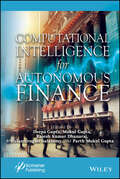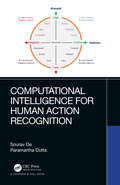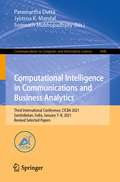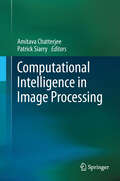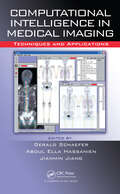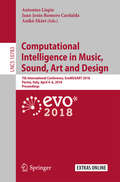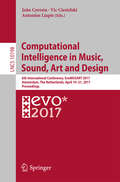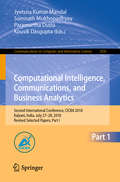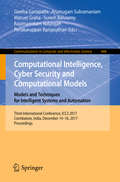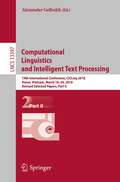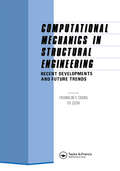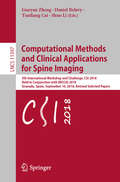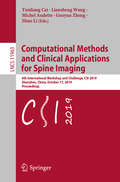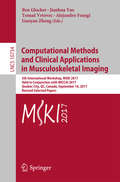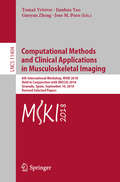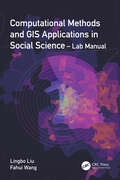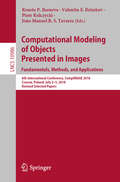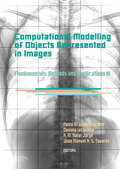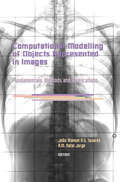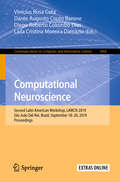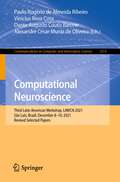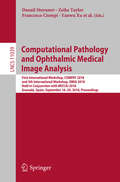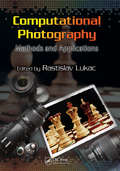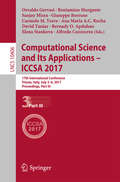- Table View
- List View
Computational Intelligence for Autonomous Finance (Fintech in a Sustainable Digital Society)
by Balamurugan Balusamy Rajesh Kumar Dhanaraj Deepa Gupta Mukul Gupta Parth Mukul GuptaThe book serves as an essential guide and a deep dive into the intersection of AI and finance, providing readers with a thorough understanding of the current state, challenges, and future possibilities of autonomous financial systems. In the rapidly evolving domain of autonomous finance, the convergence of computational intelligence techniques and financial technologies has paved the way for a new era of financial services. This transformation is driven by the integration of artificial intelligence (AI), machine learning (ML), blockchain, and big data analytics into financial systems, leading to the development of more responsive, efficient, and personalized financial products and services. Computational Intelligence for Autonomous Finance delves into the heart of this technological revolution, offering a comprehensive exploration of the theoretical foundations, practical applications, and future prospects of computational intelligence in the financial sector. The backbone of autonomous finance is a complex, interconnected ecosystem that leverages computational intelligence to automate decision-making processes, optimize financial operations, and enhance customer experiences. The book introduces the concept of an Intelligent Autonomous Financial Network (IAFN), which integrates various computational intelligence techniques with cutting-edge financial technologies to create a self-organizing, adaptive, and scalable financial system. The IAFN framework facilitates seamless interactions between diverse financial entities, enabling the provision of innovative financial services such as automated trading, real-time risk management, personalized financial planning, and fraud detection. The book meticulously analyzes the key challenges including data security and privacy concerns, algorithmic biases, regulatory compliance, and the need for interoperable standards. It also presents state-of-the-art solutions and best practices for overcoming these challenges, emphasizing the importance of ethical AI, robust data protection mechanisms, transparent algorithms, and collaborative regulatory frameworks. It discusses emerging trends such as quantum computing, edge computing, and decentralized finance (DeFi), highlighting their potential to further transform the financial landscape. The book also addresses the societal implications of autonomous finance, including its impact on employment, wealth distribution, and financial inclusion, advocating for a balanced approach that maximizes benefits while minimizing negative outcomes. Audience This book is aimed at researchers, industry professionals, policymakers, and graduate students in finance, computational intelligence, and related fields.
Computational Intelligence for Human Action Recognition (Chapman & Hall/CRC Computational Intelligence and Its Applications)
by Sourav De and Paramartha DuttaHuman Action Recognition is a challenging area presently. The vigor of research effort directed towards this domain is self indicative of this. With the ever-increasing involvement of Computational Intelligence in our day to day applications, the necessity of human activity recognition has been able to make its presence felt to the concerned research community. The primary drive of such an effort is to equip the computing system capable of recognizing and interpreting human activities from posture, pose, gesture, facial expression etc. The intent of human activity recognition is a formidable component of cognitive science in which researchers are actively engaged of late. Features: A systematic overview of the state-of-the-art in computational intelligence techniques for human action recognition. Emphasized on different intelligent techniques to recognize different human actions. Discussed about the automation techniques to handle human action recognition. Recent research results and some pointers to future advancements in this arena. In the present endeavour the editors intend to come out with a compilation that reflects the concerns of relevant research community. The readers would be able to come across some of the latest findings of active researchers of the concerned field. It is anticipated that this treatise shall be useful to the readership encompassing students at undergraduate and postgraduate level, researchers active as well as aspiring, not to speak of the senior researchers.
Computational Intelligence in Communications and Business Analytics: Third International Conference, CICBA 2021, Santiniketan, India, January 7–8, 2021, Revised Selected Papers (Communications in Computer and Information Science #1406)
by Paramartha Dutta Somnath Mukhopadhyay Jyotsna K. MandalThis book constitutes the refereed proceedings of the Third International Conference on Computational Intelligence, Communications, and Business Analytics, CICBA 2021, held in Santiniketan, India, in January 2021.The 12 full papers and 8 short papers presented in this volume were carefully reviewed and selected from 84 submissions. The papers are organized in topical sections on computational forensic (privacy and security); computational intelligence; data science and advanced data analytics; and intelligent data mining and data warehousing.
Computational Intelligence in Image Processing
by Patrick Siarry Amitava ChatterjeeComputational intelligence based techniques have firmly established themselves as viable, alternate, mathematical tools for more than a decade. They have been extensively employed in many systems and application domains, among these signal processing, automatic control, industrial and consumer electronics, robotics, finance, manufacturing systems, electric power systems, and power electronics. Image processing is also an extremely potent area which has attracted the attention of many researchers who are interested in the development of new computational intelligence-based techniques and their suitable applications, in both research problems and in real-world problems. Part I of the book discusses several image preprocessing algorithms; Part II broadly covers image compression algorithms; Part III demonstrates how computational intelligence-based techniques can be effectively utilized for image analysis purposes; and Part IV shows how pattern recognition, classification and clustering-based techniques can be developed for the purpose of image inferencing. The book offers a unified view of the modern computational intelligence techniques required to solve real-world problems and it is suitable as a reference for engineers, researchers and graduate students.
Computational Intelligence in Medical Imaging: Techniques and Applications
by Gerald Schaefer Aboul Ella Hassanien Jianmin JiangCI Techniques & Algorithms for a Variety of Medical Imaging SituationsDocuments recent advances and stimulates further researchA compilation of the latest trends in the field, Computational Intelligence in Medical Imaging: Techniques and Applications explores how intelligent computing can bring enormous benefit to existing technology in medical
Computational Intelligence in Music, Sound, Art and Design
by Antonios Liapis Juan Jesús Romero Cardalda Anikó EkártThis book constitutes the refereed proceedings of the 7th International Conference on Evolutionary Computation in Combinatorial Optimization, EvoMUSART 2018, held in Parma, Italy, in April 2018, co-located with the Evo*2017 events EuroGP, EvoCOP and EvoApplications. The 21 revised full papers presented were carefully reviewed and selected from 33 submissions. The papers cover a wide range of topics and application areas, including: generative approaches to music and visual art; medical art therapy; visualization in virtual reality; jewellery design; interactive evolutionary computation; and the art theory of evolutionary computation.
Computational Intelligence in Music, Sound, Art and Design: 6th International Conference, EvoMUSART 2017, Amsterdam, The Netherlands, April 19–21, 2017, Proceedings (Lecture Notes in Computer Science #10198)
by João Correia, Vic Ciesielski and Antonios LiapisThis book constitutes the refereed proceedings of the 6th International Conference on Evolutionary Computation in Combinatorial Optimization, EvoMUSART 2017, held in Amsterdam, The Netherlands, in April 2017, co-located with the Evo*2017 events EuroGP, EvoCOP and EvoApplications. The 24 revised full papers presented were carefully reviewed and selected from 29 submissions. The papers cover a wide range of topics and application areas, including: generative approaches to music, graphics, game content, and narrative; music information retrieval; computational aesthetics; the mechanics of interactive evolutionary computation; computer-aided design; and the art theory of evolutionary computation.
Computational Intelligence, Communications, and Business Analytics: Second International Conference, CICBA 2018, Kalyani, India, July 27–28, 2018, Revised Selected Papers, Part I (Communications in Computer and Information Science #1030)
by Paramartha Dutta Jyotsna Kumar Mandal Somnath Mukhopadhyay Kousik DasguptaThe two volume set CCIS 1030 and 1031 constitutes the refereed proceedings of the First International Conference on Computational Intelligence, Communications, and Business Analytics, CICBA 2018, held in Kalyani, India, in July 2018.The 76 revised full papers presented in the two volumes were carefully reviewed and selected from 240 submissions. The papers are organized in topical sections on computational intelligence; signal processing and communications; microelectronics, sensors, and intelligent networks; data science & advanced data analytics; intelligent data mining & data warehousing; and computational forensics (privacy and security).
Computational Intelligence, Cyber Security and Computational Models. Models and Techniques for Intelligent Systems and Automation: Third International Conference, ICC3 2017, Coimbatore, India, December 14-16, 2017, Proceedings (Communications in Computer and Information Science #844)
by Manuel Graña Geetha Ganapathi Arumugam Subramaniam Suresh Balusamy Rajamanickam Natarajan Periakaruppan RamanathanThis book constitutes the proceedings of the Third International Conference on Computational Intelligence, Cyber Security, and Computational Models, ICC3 2017, which was held in Coimbatore, India, in December 2017. The 15 papers presented in this volume were carefully reviewed and selected from 63 submissions. They were organized in topical sections named: computational intelligence; cyber security; and computational models.
Computational Linguistics and Intelligent Text Processing: 19th International Conference, CICLing 2018, Hanoi, Vietnam, March 18–24, 2018, Revised Selected Papers, Part II (Lecture Notes in Computer Science #13397)
by Alexander GelbukhThe two-volume set LNCS 13396 and 13397 constitutes revised selected papers from the CICLing 2018 conference which took place in Hanoi, Vietnam, in March 2018.The total of 68 papers presented in the two volumes was carefully reviewed and selected from 181 submissions. The focus of the conference was on following topics such as computational linguistics and intelligent text and speech processing and others. The papers are organized in the following topical sections: General, Author profiling and authorship attribution, social network analysis, Information retrieval, information extraction, Lexical resources, Machine translation, Morphology, syntax, Semantics and text similarity, Sentiment analysis, Syntax and parsing, Text categorization and clustering, Text generation, and Text mining.
Computational Mechanics in Structural Engineering: Recent developments and future trends
by Franklin Y. Cheng Fu ZizhiProceedings of Sino-US Joint Symposium/Workshop on Recent Developments and Future Trends of Computational Mechanics in Structural Engineering, Beijing, China, September 24-28 1991
Computational Methods and Clinical Applications for Spine Imaging: 5th International Workshop and Challenge, CSI 2018, Held in Conjunction with MICCAI 2018, Granada, Spain, September 16, 2018, Revised Selected Papers (Lecture Notes in Computer Science #11397)
by Guoyan Zheng Shuo Li Daniel Belavy Yunliang CaiThis book constitutes the refereed proceedings of the 5th International Workshop and Challenge on Computational Methods and Clinical Applications for Spine Imaging, CSI 2018, held in conjunction with MICCAI 2018, in Granada, Spain, in September 2018. The 8 full papers presented together with 8 short papers and 1 keynote were carefully reviewed and selected for inclusion in this volume. Papers on novel methodology and clinical research, and also papers which demonstrate the performance of methods on the provided challenges, the aim is to cover both theoretical and very practical aspects of computerized spinal imaging.
Computational Methods and Clinical Applications for Spine Imaging: 6th International Workshop and Challenge, CSI 2019, Shenzhen, China, October 17, 2019, Proceedings (Lecture Notes in Computer Science #11963)
by Guoyan Zheng Shuo Li Yunliang Cai Liansheng Wang Michel AudetteThis book constitutes the proceedings of the 7th International Workshop and Challenge on Computational Methods and Clinical Applications for Spine Imaging, CSI 2019, which was held in conjunction with MICCAI on October 17, 2019, in Shenzhen, China. All submissions were accepted for publication; the book contains 5 peer-reviewed regular papers, covering topics of vertrebra detection, spine segmentation and image-based diagnosis, and 9 challenge papers, investigating (semi-)automatic spinal curvature estimation algorithms and providing a standard evaluation framework with a set of x-ray images.
Computational Methods and Clinical Applications in Musculoskeletal Imaging: 5th International Workshop, MSKI 2017, Held in Conjunction with MICCAI 2017, Quebec City, QC, Canada, September 10, 2017, Revised Selected Papers (Lecture Notes in Computer Science #10734)
by Tomaž Vrtovec Jianhua Yao Ben Glocker Alejandro Frangi Guoyan ZhengThis book constitutes the refereed proceedings of the 5th International Workshop and Challenge on Computational Methods and Clinical Applications for Musculoskeletal Imaging, MSKI 2017, held in conjunction with MICCAI 2017, in Quebec City, QC, Canada, in September 2017. The 13 workshop papers were carefully reviewed and selected for inclusion in this volume. Topics of interest include all major aspects of musculoskeletal imaging, for example: clinical applications of musculoskeletal computational imaging; computer-aided detection and diagnosis of conditions of the bones, muscles and joints; image-guided musculoskeletal surgery and interventions; image-based assessment and monitoring of surgical and pharmacological treatment; segmentation, registration, detection, localization and visualization of the musculoskeletal anatomy; statistical and geometrical modeling of the musculoskeletal shape and appearance; image-based microstructural characterization of musculoskeletal tissue; novel techniques for musculoskeletal imaging.
Computational Methods and Clinical Applications in Musculoskeletal Imaging: 6th International Workshop, MSKI 2018, Held in Conjunction with MICCAI 2018, Granada, Spain, September 16, 2018, Revised Selected Papers (Lecture Notes in Computer Science #11404)
by Tomaž Vrtovec Jianhua Yao Guoyan Zheng Jose M. PozoThis book constitutes the refereed proceedings of the 6th International Workshop on Computational Methods and Clinical Applications for Musculoskeletal Imaging, MSKI 2018, held in conjunction with MICCAI 2018, in Granada, Spain, in September 2018. The 13 workshop papers were carefully reviewed and selected for inclusion in this volume. Topics of interest include all major aspects of musculoskeletal imaging, for example: clinical applications of musculoskeletal computational imaging; computer-aided detection and diagnosis of conditions of the bones, muscles and joints; image-guided musculoskeletal surgery and interventions; image-based assessment and monitoring of surgical and pharmacological treatment; segmentation, registration, detection, localization and visualization of the musculoskeletal anatomy; statistical and geometrical modeling of the musculoskeletal shape and appearance; image-based microstructural characterization of musculoskeletal tissue; novel techniques for musculoskeletal imaging.
Computational Methods and GIS Applications in Social Science
by Fahui Wang Lingbo LiuThis textbook integrates GIS, spatial analysis, and computational methods for solving real-world problems in various policy-relevant social science applications. Thoroughly updated, the third edition showcases the best practices of computational spatial social science and includes numerous case studies with step-by-step instructions in ArcGIS Pro and open-source platform KNIME. Readers sharpen their GIS skills by applying GIS techniques in detecting crime hotspots, measuring accessibility of primary care physicians, forecasting the impact of hospital closures on local community, or siting the best locations for business. FEATURES Fully updated using the latest version of ArcGIS Pro and open-source platform KNIME Features two brand-new chapters on agent-based modeling and big data analytics Provides newly automated tools for regionalization, functional region delineation, accessibility measures, planning for maximum equality in accessibility, and agent-based crime simulation Includes many compelling examples and real-world case studies related to social science, urban planning, and public policy Provides a website for downloading data and programs for implementing all case studies included in the book and the KNIME lab manual Intended for students taking upper-level undergraduate and graduate-level courses in quantitative geography, spatial analysis, and GIS applications, as well as researchers and professionals in fields such as geography, city and regional planning, crime analysis, public health, and public administration.
Computational Methods and GIS Applications in Social Science - Lab Manual
by Fahui Wang Lingbo LiuThis lab manual is a companion to the third edition of the textbook Computational Methods and GIS Applications in Social Science. It uses the open-source platform KNIME to illustrate a step-by-step implementation of each case study in the book. KNIME is a workflow-based platform supporting visual programming and multiple scripting language such as R, Python, and Java. The intuitive, structural workflow not only helps students better understand the methodology of each case study in the book, but also enables them to easily replicate, transplant and expand the workflow for further exploration with new data or models. This lab manual could also be used as a GIS automation reference for advanced users in spatial analysis. FEATURES The first hands-on, open-source KNIME lab manual written in tutorial style and focused on GIS applications in social science Includes 22 case studies from the United States and China that parallel the methods developed in the textbook Provides clear step-by-step explanations on how to use the open-source platform KNIME to understand basic and advanced analytical methods through real-life case studies Enables readers to easily replicate and expand their work with new data and models A valuable guide for students and practitioners worldwide engaged in efforts to develop GIS automation in spatial analysis This lab manual is intended for upper-level undergraduate and graduate students taking courses in quantitative geography, spatial analysis, GIS applications in socioeconomic studies, GIS applications in business, and location theory, as well as researchers in the similar fields of geography, city and regional planning, sociology, and public administration.
Computational Modeling of Objects Presented in Images. Fundamentals, Methods, and Applications: 6th International Conference, CompIMAGE 2018, Cracow, Poland, July 2–5, 2018, Revised Selected Papers (Lecture Notes in Computer Science #10986)
by Reneta P. Barneva Valentin E. Brimkov Piotr Kulczycki João Manuel TavaresThis book constitutes the refereed post-conference proceedings of the 6th International Symposium on Computational Modeling of Objects Presented in Images, CompIMAGE 2018, held in Cracow, Poland, inJuly 2018.The 16 revised full papers presented in this book were carefully reviewed and selected from 30 submissions. The papers cover the following topics: digital geometry; digital tomography; and methods and applications.
Computational Modelling of Objects Represented in Images III: Fundamentals, Methods and Applications
by Paolo Di Giamberardino & Daniela Iacoviello R.M. Natal Jorge & João Manuel R.S. TavaresComputational Modelling of Objects Represented in Images: Fundamentals, Methods and Applications III contains all contributions presented at the International Symposium CompIMAGE 2012 - Computational Modelling of Object Presented in Images: Fundamentals, Methods and Applications (Rome, Italy, 5-7 September 2012). The contributions cover the state-o
Computational Modelling of Objects Represented in Images. Fundamentals, Methods and Applications: Proceedings of the International Symposium CompIMAGE 2006 (Coimbra, Portugal, 20-21 October 2006) (Lecture Notes In Computer Science / Image Processing, Computer Vision, Pattern Recognition, And Graphics Ser.)
by João Manuel R.S. Tavares R.M. Natal JorgeThis book contains keynote lectures and full papers presented at the International Symposium on Computational Modelling of Objects Represented in Images (CompIMAGE), held in Coimbra, Portugal, on 20-21 October 2006. International contributions from nineteen countries provide a comprehensive coverage of the current state-of-the-art in the fields of: - Image Processing and Analysis; - Image Segmentation; - Data Interpolation; - Registration, Acquisition and Compression; - 3D Reconstruction; - Objects Tracking; - Motion and Deformation Analysis; - Objects Simulation; - Medical Imaging; - Computational Bioimaging and Visualization. Related techniques also covered in this book include the finite element method, modal analyses, stochastic methods, principal and independent components analyses and distribution models. Computational Modelling of Objects Represented in Images will be useful to academics, researchers and professionals in Computational Vision (image processing and analysis), Computer Sciences, and Computational Mechanics.
Computational Neuroscience: Second Latin American Workshop, LAWCN 2019, São João Del-Rei, Brazil, September 18–20, 2019, Proceedings (Communications in Computer and Information Science #1068)
by Dante Augusto Couto Barone Vinícius Rosa Cota Diego Roberto Colombo Dias Laila Cristina Moreira DamázioThis book constitutes the thoroughly refereed proceedings of the Second International Workshop of Computational Neuroscience, held in São João Del-Rei, Brazil, in September 2019. The 17 full papers and 3 short papers presented have been thoroughly reviewed and selected from 45 submissions. The papers are organized in topical sections: artificial intelligence, machine learning, and related topics; complex systems and complex networks; computational neuroscience of learning and memory; neural signal processing; software and hardware implementations in neuroscience; brain-machine interfaces and neurostimulation; and seizure prediction.
Computational Neuroscience: Third Latin American Workshop, LAWCN 2021, São Luís, Brazil, December 8–10, 2021, Revised Selected Papers (Communications in Computer and Information Science #1519)
by Dante Augusto Couto Barone Vinícius Rosa Cota Paulo Rogério de Almeida Ribeiro Alexandre César Muniz de OliveiraThis book constitutes the refereed proceedings of the Third Latin American Workshop, LAWCN 2021, held in Sao Luis do Maranhao, Brazil, during December 8–10, 2021.The 13 full papers and 3 short papers included in this book were carefully reviewed and selected from 27 submissions. They were organized in topical sections as follows: Interdisciplinary applications of Artificial Intelligence (AI) and Machine Learning (ML); AI and ML applied to robotics; AI and ML applied to biomedical sciences; Health issues and computational neuroscience; Software and hardware implementations in neuroscience; and Neuroengineering – science and technology.
Computational Pathology and Ophthalmic Medical Image Analysis: First International Workshop, COMPAY 2018, and 5th International Workshop, OMIA 2018, Held in Conjunction with MICCAI 2018, Granada, Spain, September 16 - 20, 2018, Proceedings (Lecture Notes in Computer Science #11039)
by Emanuele Trucco Lena Maier-Hein Hrvoje Bogunovic Yanwu Xu Danail Stoyanov Zeike Taylor Anne Martel Francesco Ciompi Nasir Rajpoot Jeroen van der Laak Mitko Veta Stephen McKenna David Snead Mona K. Garvin Xin Jan ChenThis book constitutes the refereed joint proceedings of the First International Workshop on Computational Pathology, COMPAY 2018, and the 5th International Workshop on Ophthalmic Medical Image Analysis, OMIA 2018, held in conjunction with the 21st International Conference on Medical Imaging and Computer-Assisted Intervention, MICCAI 2018, in Granada, Spain, in September 2018. The 19 full papers (out of 25 submissions) presented at COMPAY 2018 and the 21 full papers (out of 31 submissions) presented at OMIA 2018 were carefully reviewed and selected. The COMPAY papers focus on artificial intelligence and deep learning. The OMIA papers cover various topics in the field of ophthalmic image analysis.
Computational Photography: Methods and Applications (Digital Imaging and Computer Vision)
by Rastislav LukacComputational photography refers broadly to imaging techniques that enhance or extend the capabilities of digital photography. This new and rapidly developing research field has evolved from computer vision, image processing, computer graphics and applied optics—and numerous commercial products capitalizing on its principles have already appeared in diverse market applications, due to the gradual migration of computational algorithms from computers to imaging devices and software. Computational Photography: Methods and Applications provides a strong, fundamental understanding of theory and methods, and a foundation upon which to build solutions for many of today's most interesting and challenging computational imaging problems. Elucidating cutting-edge advances and applications in digital imaging, camera image processing, and computational photography, with a focus on related research challenges, this book: Describes single capture image fusion technology for consumer digital cameras Discusses the steps in a camera image processing pipeline, such as visual data compression, color correction and enhancement, denoising, demosaicking, super-resolution reconstruction, deblurring, and high dynamic range imaging Covers shadow detection for surveillance applications, camera-driven document rectification, bilateral filtering and its applications, and painterly rendering of digital images Presents machine-learning methods for automatic image colorization and digital face beautification Explores light field acquisition and processing, space-time light field rendering, and dynamic view synthesis with an array of cameras Because of the urgent challenges associated with emerging digital camera applications, image processing methods for computational photography are of paramount importance to research and development in the imaging community. Presenting the work of leading experts, and edited by a renowned authority in digital color imaging and camera image processing, this book considers the rapid developments in this area and addresses very particular research and application problems. It is ideal as a stand-alone professional reference for design and implementation of digital image and video processing tasks, and it can also be used to support graduate courses in computer vision, digital imaging, visual data processing, and computer graphics, among others.
Computational Science and Its Applications – ICCSA 2017: 17th International Conference, Trieste, Italy, July 3-6, 2017, Proceedings, Part III (Lecture Notes in Computer Science #10406)
by Alfredo Cuzzocrea Osvaldo Gervasi Beniamino Murgante Sanjay Misra Carmelo M. Torre David Taniar Bernady O. Apduhan Elena Stankova Giuseppe Borruso Ana Maria A.C. RochaThe six-volume set LNCS 10404-10409 constitutes the refereed proceedings of the 17th International Conference on Computational Science and Its Applications, ICCSA 2017, held in Trieste, Italy, in July 2017. The 313 full papers and 12 short papers included in the 6-volume proceedings set were carefully reviewed and selected from 1052 submissions. Apart from the general tracks, ICCSA 2017 included 43 international workshops in various areas of computational sciences, ranging from computational science technologies to specific areas of computational sciences, such as computer graphics and virtual reality. Furthermore, this year ICCSA 2017 hosted the XIV International Workshop On Quantum Reactive Scattering. The program also featured 3 keynote speeches and 4 tutorials.
